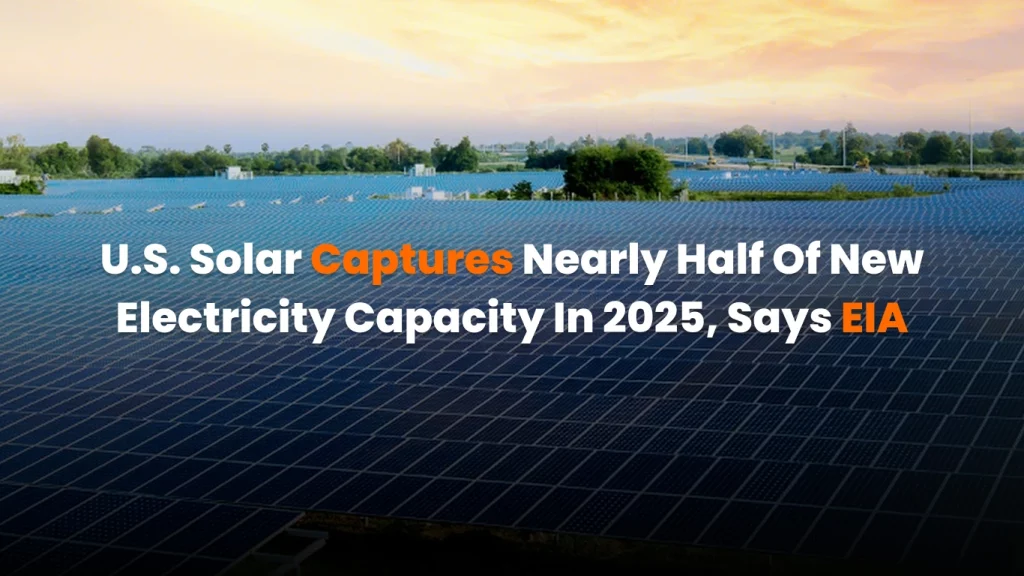In a landmark development for the renewable energy sector, the U.S. Energy Information Administration (EIA) forecasts that solar power will make up roughly 50% of all new electricity generating capacity added in the United States in 2025. This expected surge is fueled by a projected 33 gigawatts (GW) of new solar installations, a figure that, if realized, would mark an unprecedented level of growth in large-scale solar deployment for the nation.
The EIA’s projections, drawn from developer surveys, indicate that solar will dominate the expansion of the U.S. power grid, achieving record-setting gains in capacity. This rise is not happening in isolation: battery storage installations are also on pace for a record year, contributing alongside solar to reshape the nation’s energy mix. Notably, the remaining portion of new capacity additions is expected to come from wind and natural gas projects.
A Closer Look at the Numbers
- Solar’s Ascendant Role
Solar power is poised to account for 33 GW of newly added generating capacity in 2025, representing half of the total additions across the U.S. power sector this year. - Battery Storage Breakdown
While the Reuters article didn’t specify exact figures for storage, supplementary data from the EIA shows that battery storage is on track to achieve record additions as well , a clear testament to the growing synergy between solar and energy storage systems. - Remaining Capacity Sources
The balance of new capacity is expected to come from traditional power sources, wind and natural gas filling out what solar does not cover.
Why This Matters
1. A Renewable Leap Forward
Solar’s projected dominance underscores its increasing viability as a clean energy powerhouse, no longer a marginal contributor but a central pillar in U.S. energy planning.
2. Matching Soaring Electricity Demand
Industries such as Big Tech data centers and large-scale commercial operations are driving unprecedented electricity demand. Solar’s scalability and emissions-free profile are critical to meeting these needs while aligning with decarbonization goals.
3. Shifting Geographies: The Rise of Texas
Texas is becoming the new hotbed for solar energy. The Lone Star State is expected to install 9.7 GW of solar capacity in the remainder of 2025, nearly half of the nation’s projected solar additions for the year. This surge is supported by favorable environmental conditions, abundant land, and rapidly growing electricity demand.
Notably, Texas has already overtaken California to become the state with the most large-scale solar capacity. Its combination of natural advantages and policy environment is driving a rapid acceleration in solar deployment.
4. Policy Uncertainty and Future Risks
Despite the bullish projections, future expansion faces potential headwinds. Many of the federal financial incentives that have fueled Solar’s growth in recent years are slated to expire or be phased out, particularly under the current administration. This introduces uncertainty for developers, especially for projects that have yet to begin construction.
Expanding the View: Broader EIA Context
The Reuters article captures the highlights, but digging deeper into the EIA’s broader data sheds further light:
- In its Preliminary Monthly Electric Generator Inventory, the EIA estimates 63 GW of new utility-scale electric generating capacity will be added in 2025, a near 30% increase over 2024’s approximate 48.6 GW.
- These projections allocate over 50% of new capacity to solar, with battery storage projected to account for around 18.2 GW of the annual additions, collectively comprising 81% of all new capacity.
- Meanwhile, EIA forecasts a lower volume of wind additions at 7.7 GW and maintains that natural gas will fill some of the remaining space, and though still part of the mix, their share looks relatively modest.
- The Short-Term Energy Outlook further highlights Solar’s role in generation growth: solar power generation in the U.S. is expected to surge 75%, increasing from 163 billion kWh in 2023 to 286 billion kWh in 2025, with wind making modest gains as well.
Key Themes and Takeaways
- Solar’s Dominance in 2025
With 33 GW projected, solar is positioned to account for one of every two gigawatts added to the U.S. power grid in 2025. - Storage to the Rescue
Battery systems are riding solar’s coattails, with annual additions expected to rival solar’s,collectively driving 81% of new capacity. - Geographic Shift Toward Texas
No longer restricted to the deserts of the Southwest, solar is booming in Texas, which alone is expected to add 9.7 GW this year. - Policy Matters
The impending roll-back of federal incentives casts a shadow over future momentum, even as deployment soars now. - The Bigger Picture
Behind these figures lies a broader energy transition, with solar and storage consolidating their roles not just as alternatives, but as mainstays.
Sources:
- Reuters: “Solar may account for half of new US electricity added this year, EIA says” (Reuters)
- EIA Preliminary Monthly Electric Generator Inventory & analysis: solar and storage share (U.S. Energy Information Administration, Saur Energy)
- EIA Short-Term Energy Outlook: solar generation growth (U.S. Energy Information Administration)
- Additional geographic context on Texas solar (pv magazine USA)




